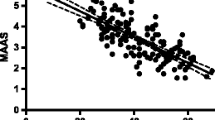Abstract
Six children with Attention Deficit Hyperactivity Disorder (ADHD) and five control children between the ages of 9 and 11 years were administered an adapted version of the Iowa Gambling Task while measuring anticipatory electrodermal response (EDR). Anticipatory EDR measures were compared between groups. Results indicate that the ADHD group exhibited significantly lower autonomic reactivity to anticipated consequences, evidencing a neuropsychological profile similar to patients with lesions in the ventromedial prefrontal cortex.


Similar content being viewed by others
References
Andreassi, J. L. (2000). Electrodermal activity (EDA) and behavior. Psychophysiology: Human behavior & physiological response (4th ed., pp. 191–202). Mahwah, NJ: Lawrence Erlbaum.
Barkley, R. (1997). Attention Deficit Hyperactivity Disorder, self-regulation, and time: Toward a more comprehensive theory. Developmental and Behavioral Pediatrics, 18, 271–279.
Barkley, R. (1998). Attention Deficit Hyperactivity Disorder: A handbook for diagnosis and treatment (2nd ed.). New York: Guilford Press.
Bechara, A., Damasio, A., Damasio, H., & Anderson, S. (1994). Insensitivity to future consequences following damage to human prefrontal cortex. Cognition, 50, 7–15.
Bechara, A., Tranel, D., Damasio, H., & Damasio, A. (1996). Failure to respond autonomically to anticipated future outcomes following damage to prefrontal cortex. Cerebral Cortex, 6, 215–225.
Casey, B. J., Castellanos, F. X., Giedd, J. N., & Marsh, W. (1997). Implication of right frontostriatal circuitry in response inhibition and attention-deficit/hyperactivity disorder. Journal of the American Academy of Child and Adolescent Psychiatry, 36(3), 374–383.
Chelune, G. J., Ferguson, W., Koon, R., & Dickey, T. O. (1986). Frontal lobe disinhibition in attention deficit disorder. Child Psychiatry and Human Development, 16, 221–234.
Colvin, M. K., Dunbar, K., & Grafman, J. (2001). The effects of frontal lobe lesions on goal achievement in the Water Jug task. Journal of Cognitive Neuroscience, 13(8), 1129–1147.
Conners, C. K., Sitarenios, G., Parker, J. D., & Epstein, J. N. (1998). The revised Conners’ Parent Rating Scale (CPRS-R): Factor structure, reliability, and criterion validity. Journal of Abnormal Child Psychology, 26(4), 257–268.
Ernst, M., Kimes, A. S., London, E. D., Matochik, J. A., Eldreth, D., Tata, S., et al. (2003). Neural substrates of decision making in adults with attention deficit hyperactivity disorder. The American Journal of Psychiatry, 160(6), 1061–1070.
Faraone, S. V., & Biederman, J. (1998). Neurobiology of Attention-Deficit Hyperactivity Disorder. Biological Psychiatry, 44, 951–958.
Filipek, P. A., Semrud-Clikeman, M., Steingard, R. J., Renshaw, P. F., Kennedy, D. N., & Biederman, J. (1997). Volumetric MRI analysis comparing subjects having attention-deficit hyperactivity disorder with normal controls. Neurology, 48(3), 589–601.
Garon, N., Moore, C., & Waschbusch, D. A. (2006). Negative affectivity predicts individual differences in decision making for preschoolers. Journal of Genetic Psychology, 167(4), 443–462.
Geurts, H. M., van der Oord, S., & Crone, E. A. (2006). Hot and cool aspects of cognitive control in children with ADHD: Decision-making and inhibition. Journal of Abnormal Child Psychology, 34(6), 813–824.
Hauser, T. U., Iannaccone, R., Ball, J., Mathys, C., Brandeis, D., Walitza, S., & Brem, S. (2014). Role of the medial prefrontal cortex in impaired decision making in juvenile attention-deficit/hyperactivity disorder. Journal of the American Medical Association Psychiatry, 7(10), 1165–1173.
Kaplan, R. F., & Stevens, M. C. (2002). A review of adult ADHD: A neuropsychological and neuroimaging perspective. CNS Spectrums, 7, 355–370.
Karalunas, S., & Huang-Pollock, C. (2011). Examining relationships between executive functioning and delay aversion in attention deficit hyperactivity disorder. Journal of Child and Adolescent Psychology, 40(6), 837–847.
Lazzaro, I., Gordon, E., Li, W., Plahn, M., Whitmont, S., Clarke, S., et al. (1999). Simultaneous EEG and EDA measures in adolescent attention deficit hyperactivity disorder. International Journal of Psychophysiology, 34, 123–134.
Loge, D. V., Staton, R. D., & Beatty, W. W. (1990). Performance of children with ADHD on tests sensitive to frontal lobe dysfunction. Journal of the Academy of Child and Adolescent Psychiatry, 4, 540–545.
Luman, M., Oosterlaan, J., Knol, D. L., & Sergeant, J. A. (2008). Decision-making in ADHD: Sensitive to frequency but blind to the magnitude of penalty? Journal of Child Psychology and Psychiatry, 49(7), 712–722.
Malloy-Diniz, L. I., Fuentes, D. D., Leite, W., Correa, H. H., & Bechara, A. A. (2007). Impulsive behavior in adults with attention deficit/hyperactivity disorder: Characterization of attentional, motor and cognitive impulsiveness. Journal of the International Neuropsychological Society, 13(4), 693–698.
Masunami, T., Okazaki, S., & Maekawa, H. (2009). Decision-making patterns and siensitivity to reward and punishment in children with attention-deficit hyperactivity disorder. International Journal of Psychphysiology, 72(3), 283–288.
Shibagaki, M., Yamanaka, T., & Furuya, T. (1993). Attention state in electrodermal activity during auditory stimulation of children with attention-deficit hyperactivity disorder. Perceptual and Motor Skills, 77, 331–338.
Sparrow, E. P. (2010). Essentials of Conners behavior assessments. Hoboken, NJ: Wiley.
Stahl, S. (2009). The prefontal cortex is out of tune in attention deficit/hyperactivity disorder. Journal of Clinical Psychiatry, 70(1), 950–951.
Yellin, A. M. (1986). Psychophysiological correlates of attention deficit disorder. Psychiatric Annals, 16, 29–32.
Author information
Authors and Affiliations
Corresponding author
Ethics declarations
Conflict of interest
The authors declare that they have no conflict of interest.
Ethical Standard
This human participants study was approved by the Institutional Review Board of the College and was performed in accordance with the ethical standards laid down in the 1964 Declaration of Helsinki and its later amendments.
Informed Consent
All participants provided informed consent prior to the study.
Rights and permissions
About this article
Cite this article
Odle, M., Ouellette, J.A. Anticipatory Electrodermal Response as a Differentiating Somatic Marker Between Children with ADHD and Controls. Appl Psychophysiol Biofeedback 41, 375–380 (2016). https://doi.org/10.1007/s10484-016-9336-y
Published:
Issue Date:
DOI: https://doi.org/10.1007/s10484-016-9336-y




